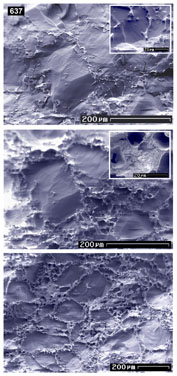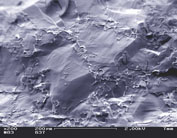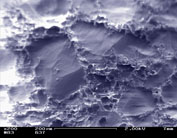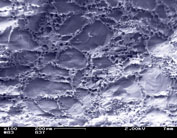LAS email 7/25/2011
You can see how the sample initially looks like it's predominantly ice, but as the ice sublimates (pretty quickly) the MPH becomes better exposed along the ice grain boundaries. The middle photo is the same area as the top photo, about 20 minutes later. The MPH is initially dense but develops surface pits after exposure to the high-vacuum conditions. Compare the MPH in the insets in the top and middle photos, and you get the idea. The bottom photo shows a lower-magnification overview that shows how uniformly the MPH rims the ice grains.
This picture was taken very early in the session so the perchlorate is just emerging. Next pic shows appearance after sublimation.
All the perchlorate-bearing samples look the same at the start, i.e. you can't really see the perchlorate right away until the ice starts sublimating. On the flip side, after significant sublimation, it makes it look like there's more perchlorate than there really is. (Which is normal.) However, you can see that after a fair bit of sublimation, that the 10% sample (637) has the "thickest" zones/rinds of perchlorate surrounding the ice grains, followed by the 5% sample (638), followed by 2% (639A) followed obviously by 0% (639B). Just what you'd expect.
 637 composite
637 composite 637_1
637_1 637_9
637_9 637_19
637_19